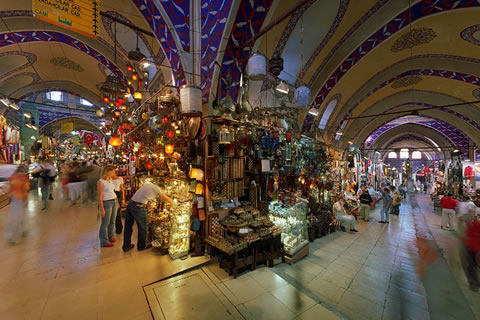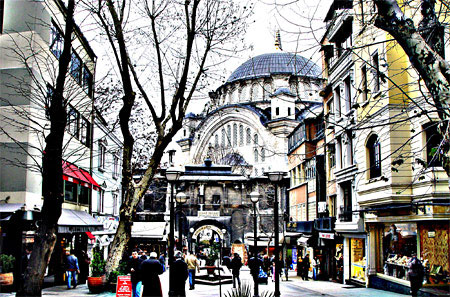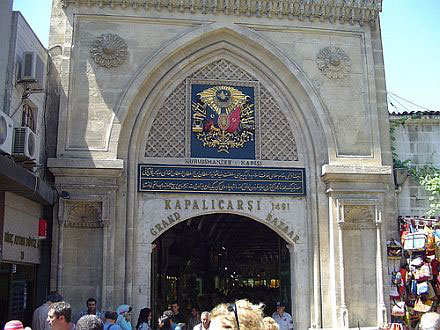Grand Bazaar
The construction of the future Grand Bazaar’s core started during the winter of 1455/56, shortly after the Ottoman conquest of Constantinople.
Sultan Mehmet II had an edifice erected devoted to the trading of textiles. In its name, Cevâhir Bedestan (English: Gems Bedesten; but also in Ottoman Turkish: Bezzâzistan-i- cedîd, meaning in English: New Bedesten) the word “Bedesten” is an alteration of the Persian word bezestan (bedesten), derived from bez (“cloth”), and means “bazaar of the cloth sellers”. The building – named alternately in Turkish “İç” (English: Internal), “Atik” (English: Ancient), or “Eski” (English: Old) Bedesten – lies on the slope of the third hill of Istanbul, between the ancient Fora of Constantine and of Theodosius. It was also near the first Sultan’s palace, the Old Palace (Turkish: Eski Sarayi), which was also in construction in those same years, and not far from the Artopoléia (Greek: Άρτοπωλεία) quarter, a location already occupied in Byzantine times by the bakers.
The construction of the Bedesten ended in the winter of 1460/61, and the building was endowed to the waqf of the Aya Sofya Mosque. Analysis of the brickwork shows that most of the structure originates from the second half of the 15th century, although a Byzantine relief representing a Comnenian eagle, still enclosed on the top of the East gate (Turkish: Kuyumcular Kapisi) of the Bedesten has been used by several scholars as proof that the edifice was a Byzantine structure.
Nuruosmaniye Gate of the Grand Bazaar
In a market near the Bedesten, named in Turkish Esir Pazarı, the slave trade was active in this zone also during the Byzantine Empire. Other important markets in the vicinity were the second-hand market (Turkish: Bit Pazarı), the “Long Market” (Turkish: Uzun Carsi), corresponding to the Greek “Makrós Émbolos” (Greek: Μακρός Ὲμβολος, English: Long Arcade, a long porticoed mall stretching downhill from the Forum of Constantine to the Golden Horn, which was one of the main market areas of the city), while the old book market (Turkish: Sahaflar Carsisi) was moved from the Bazaar to the present picturesque location near the Beyazid Mosque only after the earthquake of 1894.
Some years later[10]—according to other sources, this occurred in 1545 under Sultan Suleyman I— Mehmet II had another covered market built, the Sandal Bedesten (the name comes from a kind of thread woven in Bursa which had the colour of sandalwood ), also named “Küçük” (English: Little), “Cedit” or “Yeni” ( both words meaning in English: New) Bedesten, which lay north of the first. After the erection of the Sandal Bedesten the trade in textiles moved there, while the Cevahir Bedesten was reserved for the trade in luxury goods. At the beginning the two buildings were isolated: according to the 16th-century French traveller Pierre Gilles between them and the Mosque of Beyazid lay ruins of churches and a large cistern;[8] but soon many sellers opened their shops between and around them, so that a whole quarter was born, devoted exclusively to commerce.
At the beginning of the seventeenth century the Grand Bazaar already had achieved its final shape. The enormous extent of the Ottoman Empire in three continents, and the total control of road communication between Asia and Europe, rendered the Bazaar and the surrounding Hans or caravanserais, the hub of the Mediterranean trade. According to several European travelers, at that time, and until the first half of the 19th century, the Market was unrivaled among the markets in Europe with regards to the abundance, variety and quality of the goods on sale. At that time we know from European travelers that the Grand Bazaar had a square plan, with two perpendicular main roads crossing in the middle and a third road running along the outer perimeter.In the Bazaar there were 67 roads (each bearing the name of the sellers of a particular good), several squares used for the daily prayers, 5 mosques, 7 fountains, 18 gates which were opened each day in the morning and closed in the evening (from these comes the modern name of the Market, “Closed Market” (Turkish: Kapalıçarşı).Around 1638 Turkish traveler Evliya Çelebi gave us the most important historical description of the Bazaar and of its customs. The number of shops amounted to 3,000, plus 300 located in the surrounding Hans, large Caravanserais with two or three storeys round a porticoed inner courtyard, where goods could be stored and merchants could be lodged. In that period one tenth of the shops of the city were concentrated in the market and around it. For all that, at that time the market was not yet covered.
Recurrent calamities, fires and earthquakes, hit the Grand Bazaar. The first fire occurred in 1515; another one happened in 1548.Other fires ravaged the complex in 1588, 1618 (when the Bit Pazari was destroyed), 1645, 1652, 1658, 1660 (on that occasion the whole city was devastated) 1687, 1688 (great damage occurred to the Uzun Carsi) 1695, 1701. The fire of 1701 was particularly fierce, forcing in 1730-31 Grand Vizier Nevşehirli Damad Ibrahim Pasha to rebuild several parts of the complex. In 1738 the Kizlar Aĝasi Beşir Ağa endowed the Fountain (still existing) near Mercan Kapi.
In this period, because of the new law against fires issued in 1696, several parts of the market which lied between the two Bedesten were covered with vaults. Despite that, other fires ravaged the complex in 1750 and 1791. The quake of 1766 caused more damages, which were repaired by Court Chief Architect (Turkish: Hassa baş Mimari) Ahmet a year later.
The Zincirli Hani, a former caravansary where now jewelry is produced.
In nineteenth century, the growth of the textile industry in western Europe, the introduction of mass production methods, the Capitulations signed between the Empire and many European countries and the forestalling – always by European merchants – of the raw materials needed to produce goods in the Empire’s closed Economy, were factors which all together provoked the decadence of the Market. By 1850, rents in Bedesten were ten times lower than two to three decades before. Moreover, the birth of a west-oriented bourgeoisie and the commercial success of the western products pushed the merchants belonging to the minorities (Greek, Armenian, Jewish) for moving out of Bazaar, perceived as antiquated, and for opening new shops in quarters frequented by Europeans, as Pera and Galata.
According to a 1890 survey, in the Bazaar were active 4,399 shops, 2 Bedesten, 2195 rooms, 1 Hamam, one mosque, 10 Medrese, 19 fountains (among them two Şadırvan and one Sebil), one Mausoleum and 24 Han. In the 30.7 hectares of the complex, protected by 18 gates, there are 3,000 shops along 61 streets, the 2 Bedesten, 13 Han (plus several more outside).
The last major catastrophe happened in 1894, and was due to the strong earthquake which rocked Istanbul in that year. The Minister of Public Works, Mahmud Celaleddin Pașa, supervised the repair of the damaged Bazaar until 1898, and on this occasion the complex was reduced in area. To the west, the Bit Pazarı was left outside the new perimeter and became an open-sky road, named Çadircilar Caddesi (English: Tentmaker Road), while the old gate and the Kütkculer Kapi were demolished. Among all the Hans which belonged to the Market, many were left outside, and only nine remained enclosed in the structure.
In 1914 the Sandal Bedesten, whose handlers of textile goods had been ruined by the European competition, was acquired by the city of Istanbul and, starting one year later, was used as an auction house, mainly for carpets. In 1927 the individual parts of the bazaar and the streets got official names. The last fires of bazaar happened in 1943 and 1954, and the related restorations were finished on 28 July 1959.
The last restoration of the complex took place in 1980. In that occasion were also removed the advertising posters which defaced the market.









